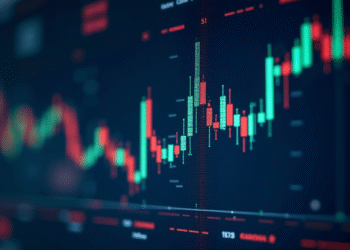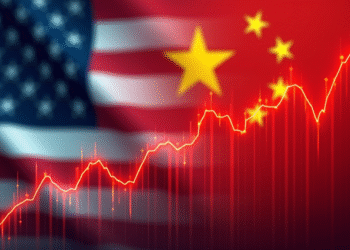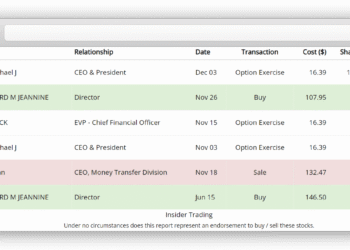SK Hynix revenue has seen an extraordinary surge of 102% in 2024, reaching 66.19 trillion won ($46.34 billion), largely fueled by the booming demand for AI memory products. As a pivotal Nvidia supplier, SK Hynix has positioned itself at the forefront of the semiconductor industry, capitalizing on the AI memory boom that is reshaping market dynamics. The company’s remarkable turnaround from losses in 2023 to a net profit of 19.79 trillion won ($13.84 billion) underscores its strategic pivot toward high-bandwidth memory solutions. Investors are keenly watching the DRAM market trends, as SK Hynix continues to innovate and expand its high-value product offerings. With its robust financial performance and focus on advanced memory technologies, SK Hynix is poised to leverage the ongoing AI revolution and enhance its position among leading semiconductor companies.
The financial landscape of SK Hynix, a major player in the semiconductor sector, has undergone a significant transformation, reflecting the broader trends in the memory technology market. With its substantial revenue growth driven by the increasing reliance on artificial intelligence, the company is not just a supplier to Nvidia but a key contributor to the evolving demands for advanced memory solutions. The surge in high-bandwidth memory products has positioned SK Hynix at the heart of the AI-driven tech revolution, attracting attention from investors and industry analysts alike. As semiconductor firms navigate the changing landscape, understanding the implications of these revenue shifts and market trends becomes essential for those looking to capitalize on the potential of AI memory technology. The implications for stock performance and investment opportunities will continue to unfold as SK Hynix leverages its strategic advancements.
SK Hynix Revenue Growth Amid AI Demand
In a remarkable turnaround, SK Hynix reported a staggering 102% increase in revenue for 2024, reaching 66.19 trillion won ($46.34 billion). This surge is primarily attributed to the soaring demand for artificial intelligence memory products, which have become pivotal in today’s tech landscape. As a key supplier to Nvidia, SK Hynix has positioned itself strategically to capitalize on the AI memory boom, which is reshaping the semiconductor industry. The company’s ability to pivot from a loss-making status in 2023 to a robust net profit of 19.79 trillion won ($13.84 billion) is a testament to its effective business strategies and strong market positioning in the face of evolving technology demands.
The fourth quarter of 2024 further illustrated SK Hynix’s impressive growth trajectory, with a 75% year-over-year revenue increase to 19.767 trillion won ($13.7 billion). This data underscores the company’s significant role in the high-bandwidth memory sector, which constitutes over 40% of its total DRAM revenue. As the global appetite for advanced memory solutions intensifies, SK Hynix’s focus on high-value products such as HBM3E and HBM4 is expected to drive continued growth and establish the company as a leader within the semiconductor arena.
Impact of AI Memory Boom on Semiconductor Companies
The AI memory boom has significantly altered the landscape for semiconductor companies, positioning those like SK Hynix, which cater to high-demand sectors, for substantial growth. As enterprises invest heavily in artificial intelligence technologies, the necessity for advanced memory solutions has surged, compelling semiconductor firms to innovate and expand their product offerings. This shift has opened new avenues for revenue generation, pushing companies to enhance their capabilities in producing high-bandwidth memory products that meet the rigorous demands of AI applications.
Moreover, as Nvidia continues to leverage its position in the AI space, its relationship with SK Hynix becomes increasingly vital. The collaboration between these tech giants not only amplifies the demand for cutting-edge memory but also establishes a competitive edge in the semiconductor market. The ripple effects of this partnership could lead to a re-evaluation of investment strategies, focusing on companies that are strategically aligned with the growth of AI technologies and memory innovations.
DRAM Market Trends and Future Outlook
The DRAM market is currently experiencing dynamic trends driven by the insatiable demand for memory solutions in AI and other high-performance computing applications. As seen in SK Hynix’s latest performance metrics, the shift towards high-bandwidth memory has become a critical focal point for growth. Companies that can adapt to these trends are likely to thrive, especially as global technology leaders increase their investments in AI infrastructure. The forecast for the DRAM sector suggests that innovations in memory technology will continue to dictate market dynamics, influencing pricing, supply, and overall demand.
Additionally, the competitive landscape of the DRAM market is expected to evolve as companies race to enhance their memory technologies. This competition will not only drive advancements in product offerings but also reshape consumer expectations and manufacturing processes. As SK Hynix and its competitors invest in research and development, the industry is poised for breakthroughs that could redefine memory performance standards, further entrenching the importance of high-bandwidth memory in the marketplace.
Investment Opportunities in AI Memory Technology
As the AI memory boom unfolds, investment opportunities in this sector are becoming increasingly attractive. Investors are keenly observing companies like SK Hynix, which are at the forefront of producing high-bandwidth memory solutions necessary for AI applications. The surge in revenue and profit margins suggests a robust growth trajectory, making semiconductor stocks compelling options for those looking to capitalize on the technology boom. Moreover, with SK Hynix raising its annual dividend by 25%, it signals a strong commitment to shareholder value and financial stability.
Investment-focused ETFs that highlight AI and semiconductor sectors are also gaining traction. These funds provide a diversified approach to investing in companies poised to benefit from the AI memory revolution. As technology continues to evolve, savvy investors are positioning themselves in the market by seeking opportunities within the AI and semiconductor landscape, which is rapidly expanding and transforming traditional investment paradigms.
The Role of Global Tech Leaders in Memory Stocks
Global tech leaders play a pivotal role in influencing memory stocks, particularly as they ramp up investments in AI technologies. Companies like Nvidia are not only driving demand for advanced memory solutions but also shaping the strategies of semiconductor manufacturers such as SK Hynix. Their commitment to developing AI infrastructure necessitates a steady supply of high-performance memory, thereby impacting the stock performance of memory producers. As these tech giants continue to innovate and expand, the ripple effects on memory stocks are profound, creating both challenges and opportunities for companies in the sector.
Furthermore, as major players in the tech industry forge partnerships and collaborate on AI initiatives, the implications for memory stocks could be significant. Increased collaboration may lead to accelerated demand for advanced memory products, boosting revenues and stock valuations for companies like SK Hynix. Investors should monitor these partnerships closely, as they may provide insights into future market trends and potential investment opportunities within the semiconductor space.
Debt Reduction and its Impact on SK Hynix Valuation
Debt reduction is a crucial factor that can significantly influence SK Hynix’s valuation and overall financial health. The company reported a notable decrease in debt by 6.8 trillion won ($4.76 billion) in 2024, which not only strengthens its balance sheet but also enhances its ability to reinvest in high-growth areas like AI memory technology. A lower debt burden can lead to improved credit ratings, reduced interest expenses, and greater flexibility to navigate market challenges, ultimately making SK Hynix a more attractive investment for shareholders.
Moreover, as SK Hynix continues to optimize its financial structure, the focus on profitability-first strategies becomes apparent. By reducing debt and increasing cash equivalents by 5.2 trillion won ($3.64 billion), the company is positioning itself for sustained growth amidst fluctuating market conditions. This proactive approach not only boosts investor confidence but also lays the groundwork for future innovations in memory solutions, ensuring that SK Hynix remains a formidable player in the semiconductor landscape.
Dividend Increases and Investor Attraction
SK Hynix’s recent decision to raise its annual dividend by 25% to 1,500 won ($1.05) per share is a clear indication of the company’s confidence in its financial performance and strategic direction. Such a move is likely to attract investors looking for stable returns, especially in a volatile stock market environment. Dividend increases can serve as a strong signal of a company’s financial health and commitment to returning value to shareholders, making SK Hynix an appealing option for income-focused investors.
The implications of this dividend increase extend beyond immediate returns; it also reflects SK Hynix’s successful navigation of the AI memory boom. As the company continues to innovate and expand its high-bandwidth memory product offerings, its ability to reward shareholders through dividends enhances its attractiveness as an investment. This strategy not only fosters investor loyalty but also positions SK Hynix favorably in the competitive semiconductor market.
Technological Advancements in Memory Products
Technological advancements in memory products are crucial for maintaining competitiveness in the semiconductor industry. SK Hynix is at the forefront of these innovations, focusing on developing next-generation high-bandwidth memory solutions like HBM3E and HBM4. These advancements are essential for meeting the increasing demands of AI applications, which require faster and more efficient memory solutions. As the company invests in research and development, it is not only enhancing its product offerings but also solidifying its position as a leader in the memory market.
The impact of these technological advancements extends beyond SK Hynix to the broader semiconductor ecosystem. As more companies adopt advanced memory technologies, the entire industry stands to benefit from improved performance and increased efficiency. This trend is particularly relevant in the context of AI and machine learning, where the need for high-speed memory is paramount. By driving innovation in memory technology, SK Hynix and its competitors are setting the stage for a more dynamic and responsive semiconductor market.
Frequently Asked Questions
What factors contributed to SK Hynix’s revenue surge in 2024?
SK Hynix’s revenue soared by 102% in 2024, primarily driven by the explosive demand for artificial intelligence memory products. As a key Nvidia supplier, the company benefited from the AI memory boom, which significantly boosted their DRAM market presence.
How does SK Hynix’s revenue growth impact its stock performance?
Despite a remarkable 102% revenue growth, SK Hynix’s stock dropped by 3.10%. This paradox can be attributed to investor sentiment and market corrections, despite the strong financial results linked to high-bandwidth memory demand.
Which high-bandwidth memory products are driving SK Hynix’s revenue?
SK Hynix has seen significant revenue growth from high-bandwidth memory (HBM), which accounted for over 40% of total DRAM revenue in 2024. Their investments in advanced technologies like HBM3E and HBM4 are expected to meet the rising demand in the semiconductor market.
How is the AI boom affecting semiconductor companies like SK Hynix?
The AI boom is positively impacting semiconductor companies, with SK Hynix experiencing a revenue increase of 102% due to heightened demand for AI memory solutions. This trend is likely to continue as global tech leaders invest in AI infrastructure.
What are the DRAM market trends influencing SK Hynix’s revenue?
Recent DRAM market trends indicate a strong demand for high-bandwidth memory and AI-related products, contributing to SK Hynix’s impressive revenue growth. The company’s focus on high value-added products has positioned it well within this evolving market.
Could SK Hynix’s dividend increase attract more investors?
Yes, SK Hynix’s decision to raise its annual dividend by 25% to 1,500 won ($1.05) per share reflects confidence in its financial position and growth potential, which could attract more investors seeking stable returns amidst the AI memory boom.
What role does Nvidia play in SK Hynix’s financial performance?
As a major supplier to Nvidia, SK Hynix’s financial performance is closely tied to Nvidia’s success in the AI sector. Increased demand for Nvidia’s products drives revenue growth for SK Hynix, particularly in the high-bandwidth memory market.
Are there any investment opportunities in AI memory technology related to SK Hynix?
Given SK Hynix’s strong performance and strategic focus on AI memory technology, there are potential investment opportunities in the sector. Investors may consider AI-focused ETFs that include semiconductor companies benefiting from the AI boom.
How does debt reduction impact SK Hynix’s valuation?
SK Hynix’s debt reduction of 6.8 trillion won ($4.76 billion) enhances its valuation by improving financial stability and reducing risk. This optimization of the balance sheet, along with significant revenue growth, positions the company favorably for future investments.
What advancements in memory technology are anticipated to influence SK Hynix’s future revenue?
Advancements in memory technology, particularly in high-bandwidth memory (HBM) products, are expected to significantly influence SK Hynix’s future revenue. The company’s ongoing investments in innovative memory solutions will align with the growing demand from the AI sector.
| Key Points | Details |
|---|---|
| Revenue Growth | SK Hynix reported a 102% increase in revenue for 2024, totaling 66.19 trillion won ($46.34 billion). This growth is attributed to high demand for AI memory products. |
| Net Profit | The company turned from a loss in 2023 to a net profit of 19.79 trillion won ($13.84 billion) in 2024. |
| Fourth-Quarter Performance | In Q4 2024, revenues rose 75% year-over-year to 19.77 trillion won ($13.7 billion), with operating profit increasing 2,236% to 8.08 trillion won ($5.66 billion). |
| High-Bandwidth Memory | High-bandwidth memory accounted for over 40% of total DRAM revenue, highlighting SK Hynix’s importance in the AI supply chain. |
| Financial Health | The company improved its financials with cash equivalents up by 5.2 trillion won ($3.64 billion) and a debt reduction of 6.8 trillion won ($4.76 billion) in 2024. |
| Dividend Increase | SK Hynix raised its annual dividend by 25% to 1,500 won ($1.05) per share, reflecting confidence in its future growth. |
| Stock Performance | Despite strong revenue growth, SK Hynix stock fell 3.10% to 218,500 won ($151.97) as of January 22, 2025, although it has increased by 55.18% over the past year. |
Summary
SK Hynix revenue soared by 102% in 2024, demonstrating the company’s successful pivot towards high-demand AI memory products. The substantial increase in revenue, alongside a significant turnaround in profitability, underscores SK Hynix’s vital role in the semiconductor supply chain for artificial intelligence. Despite the impressive financial performance, the stock experienced a decline, indicating market volatility or investor concerns that could affect future performance. Overall, SK Hynix’s financial health, coupled with strategic investments in advanced memory technologies, positions the company well for continued growth in an evolving tech landscape.













